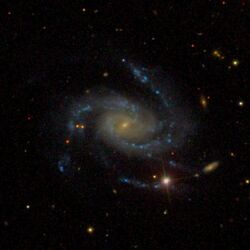Astronomy:NGC 7610
From HandWiki
Short description: Galaxy in the constellation Pegasus
| NGC 7610 | |
|---|---|
 SDSS image of NGC 7610 | |
| Observation data (J2000 epoch) | |
| Constellation | Pegasus |
| Right ascension | 23h 19m 41.4s[1] |
| Declination | +10° 11′ 06″[1] |
| Helio radial velocity | 3554 km/s[1] |
| Distance | 160 Mly[2] |
| Apparent magnitude (V) | +13.44[1] |
| Characteristics | |
| Type | Scd[1] |
| Apparent size (V) | 2.5′ × 1.9′[1] |
| Other designations | |
| UGC 12511, PGC 071087,[1] | |
NGC 7610 is a spiral galaxy in the constellation Pegasus. Discovered by Andrew Ainslie Common in August 1880, it was accidentally "rediscovered" by him the same month, and later given the designation NGC 7616.[3]
Supernova
In October 2013 SN 2013fs was discovered in NGC 7610. It was detected approximately 3 hours after the light from the explosion reached Earth, and within a few hours optical spectra were obtained - the earliest such observations ever made of a supernova.[2]
References
- ↑ Jump up to: 1.0 1.1 1.2 1.3 1.4 1.5 1.6 "NED results for object NGC 7610". https://ned.ipac.caltech.edu/cgi-bin/objsearch?objname=ngc+7610&extend=no&hconst=73&omegam=0.27&omegav=0.73&corr_z=1&out_csys=Equatorial&out_equinox=J2000.0&obj_sort=RA+or+Longitude&of=pre_text&zv_breaker=30000.0&list_limit=5&img_stamp=YES. Retrieved 17 February 2017.
- ↑ Jump up to: 2.0 2.1 Perkins, Sid (2017-02-13). "Exploding Star Yields its Secrets". AAAS. https://www.science.org/content/article/exploding-star-yields-its-secrets. Retrieved 15 February 2017.
- ↑ Seligman, Courtney. "NGC Objects: NGC 7600 - 7649". http://cseligman.com/text/atlas/ngc76.htm#7610. Retrieved 17 February 2017.
External links
 |

